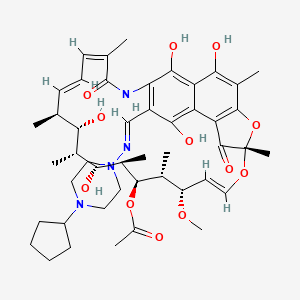
Rifapentina
- Haga clic en CONSULTA RÁPIDA para recibir una cotización de nuestro equipo de expertos.
- Con productos de calidad a un precio COMPETITIVO, puede centrarse más en su investigación.
Descripción general
Descripción
Rifapentine, sold under the brand name Priftin, is an antibiotic used primarily in the treatment of tuberculosis. It belongs to the rifamycin class of antibiotics and is known for its ability to inhibit bacterial RNA synthesis by targeting DNA-dependent RNA polymerase . This compound is particularly effective against Mycobacterium tuberculosis, the bacterium responsible for tuberculosis .
Aplicaciones Científicas De Investigación
Rifapentine has a wide range of scientific research applications:
Mecanismo De Acción
Target of Action
Rifapentine, an antibiotic agent used in the treatment of pulmonary tuberculosis, primarily targets the DNA-dependent RNA polymerase in susceptible cells . This enzyme plays a crucial role in the transcription process, where it catalyzes the synthesis of RNA from DNA.
Mode of Action
It acts via the inhibition of DNA-dependent RNA polymerase, leading to a suppression of RNA synthesis and cell death . This interaction disrupts the transcription process, preventing the bacteria from synthesizing essential proteins, thereby inhibiting their growth and proliferation .
Biochemical Pathways
Rifapentine affects the transcription pathway in bacteria. By inhibiting the DNA-dependent RNA polymerase, it disrupts the conversion of DNA into RNA, a critical step in protein synthesis . This disruption affects downstream processes, including protein synthesis and subsequent cellular functions, ultimately leading to bacterial cell death .
Pharmacokinetics
Rifapentine exhibits certain ADME (Absorption, Distribution, Metabolism, and Excretion) properties that impact its bioavailability. It is well absorbed when taken orally and is distributed widely in body tissues and fluids, including the cerebrospinal fluid . It undergoes hepatic metabolism, where it is hydrolyzed by an esterase enzyme to form the active metabolite 25-desacetyl rifapentine . The drug is primarily excreted in the feces (70%), with a smaller portion excreted in the urine (17%, primarily as metabolites) . The time to peak serum concentration is between 3 to 10 hours, and the elimination half-life of rifapentine is approximately 17 hours .
Result of Action
The molecular and cellular effects of rifapentine’s action result in the suppression of RNA synthesis, leading to cell death . It has shown higher bacteriostatic and bactericidal activities, especially against intracellular bacteria growing in human monocyte-derived macrophages . It is bactericidal and has a very broad spectrum of activity against most gram-positive and gram-negative organisms, including Mycobacterium tuberculosis .
Action Environment
Environmental factors can influence the action, efficacy, and stability of rifapentine. For instance, the presence of food can increase the absorption of rifapentine, enhancing its bioavailability . Additionally, rifapentine’s efficacy can be influenced by the patient’s age, with clearance decreasing with increasing age . Furthermore, rifapentine’s action can be affected by the presence of other drugs, as it is known to induce the cytochrome P450 enzyme system, potentially leading to reduced bioavailability and enhanced clearance of some coadministered medications .
Análisis Bioquímico
Biochemical Properties
Rifapentine inhibits DNA-dependent RNA polymerase activity in susceptible cells . Specifically, it interacts with bacterial RNA polymerase but does not inhibit the mammalian enzyme . This interaction is crucial for its role in biochemical reactions.
Cellular Effects
Rifapentine has shown higher bacteriostatic and bactericidal activities especially against intracellular bacteria growing in human monocyte-derived macrophages . It influences cell function by suppressing RNA synthesis, leading to cell death .
Molecular Mechanism
The molecular mechanism of Rifapentine involves the inhibition of DNA-dependent RNA polymerase, leading to a suppression of RNA synthesis and cell death . It exerts its effects at the molecular level through binding interactions with biomolecules, specifically bacterial RNA polymerase .
Temporal Effects in Laboratory Settings
Stability concerns have been raised for Rifapentine stored under certain conditions .
Metabolic Pathways
Rifapentine is metabolized in the liver and eliminated in bile and, to a much lesser extent, in urine
Transport and Distribution
Rifapentine is well absorbed when taken orally and is distributed widely in body tissues and fluids, including the cerebrospinal fluid
Métodos De Preparación
Synthetic Routes and Reaction Conditions: Rifapentine is synthesized starting from rifamycin S. The process involves several key steps:
Conversion to Intermediate: Rifamycin S reacts with dihydroxy methyl tert-butyl amine in an organic solvent to form an intermediate called rifaoxazine.
Hydrolysis and Ring Opening: The intermediate undergoes hydrolysis and ring opening in the presence of a catalyst and a reductant in a second organic solvent.
Condensation: The hydrolysis product is then condensed with 1-amino-4-cyclopentyl piperazine to form rifapentine.
Industrial Production Methods: The industrial production of rifapentine involves scaling up the laboratory synthesis process. Key challenges include maintaining the purity and uniformity of the product, optimizing reaction conditions, and ensuring efficient crystallization and drying processes .
Análisis De Reacciones Químicas
Types of Reactions: Rifapentine undergoes several types of chemical reactions, including:
Oxidation: Rifapentine can be oxidized under certain conditions, leading to the formation of various oxidation products.
Reduction: Reduction reactions can modify the functional groups on the rifapentine molecule.
Substitution: Substitution reactions can occur, particularly at the piperazine ring, leading to the formation of different derivatives.
Common Reagents and Conditions:
Oxidation: Common oxidizing agents include hydrogen peroxide and potassium permanganate.
Reduction: Reducing agents such as sodium borohydride and lithium aluminum hydride are often used.
Substitution: Substitution reactions typically involve nucleophiles like amines and alcohols.
Major Products: The major products formed from these reactions include various oxidized, reduced, and substituted derivatives of rifapentine .
Comparación Con Compuestos Similares
Rifampin: Commonly used in combination therapy for tuberculosis.
Rifabutin: Used primarily in the treatment of Mycobacterium avium complex infections.
Rifapentine’s unique pharmacokinetic properties and its efficacy in shorter treatment regimens make it a valuable addition to the arsenal against tuberculosis .
Propiedades
| Rifapentine has shown higher bacteriostatic and bactericidal activities especially against intracellular bacteria growing in human monocyte-derived macrophages. Rifapentine inhibits DNA-dependent RNA polymerase in susceptible strains of M. tuberculosis. Rifapentine acts via the inhibition of DNA-dependent RNA polymerase, leading to a suppression of RNA synthesis and cell death. | |
Número CAS |
61379-65-5 |
Fórmula molecular |
C47H64N4O12 |
Peso molecular |
877.0 g/mol |
Nombre IUPAC |
[(7S,9E,11S,12R,13S,14R,15R,16R,17S,18S,19E,21Z)-26-[(4-cyclopentylpiperazin-1-yl)iminomethyl]-2,15,17,27,29-pentahydroxy-11-methoxy-3,7,12,14,16,18,22-heptamethyl-6,23-dioxo-8,30-dioxa-24-azatetracyclo[23.3.1.14,7.05,28]triaconta-1(29),2,4,9,19,21,25,27-octaen-13-yl] acetate |
InChI |
InChI=1S/C47H64N4O12/c1-24-13-12-14-25(2)46(59)49-37-32(23-48-51-20-18-50(19-21-51)31-15-10-11-16-31)41(56)34-35(42(37)57)40(55)29(6)44-36(34)45(58)47(8,63-44)61-22-17-33(60-9)26(3)43(62-30(7)52)28(5)39(54)27(4)38(24)53/h12-14,17,22-24,26-28,31,33,38-39,43,53-57H,10-11,15-16,18-21H2,1-9H3,(H,49,59)/b13-12+,22-17+,25-14-,48-23?/t24-,26+,27+,28+,33-,38-,39+,43+,47-/m0/s1 |
Clave InChI |
WDZCUPBHRAEYDL-LYDPARFQSA-N |
SMILES |
CC1C=CC=C(C(=O)NC2=C(C(=C3C(=C2O)C(=C(C4=C3C(=O)C(O4)(OC=CC(C(C(C(C(C(C1O)C)O)C)OC(=O)C)C)OC)C)C)O)O)C=NN5CCN(CC5)C6CCCC6)C |
SMILES isomérico |
C[C@H]1/C=C/C=C(\C(=O)NC2=C(C(=C3C(=C2O)C(=C(C4=C3C(=O)[C@](O4)(O/C=C/[C@@H]([C@H]([C@H]([C@@H]([C@@H]([C@@H]([C@H]1O)C)O)C)OC(=O)C)C)OC)C)C)O)O)C=NN5CCN(CC5)C6CCCC6)/C |
SMILES canónico |
CC1C=CC=C(C(=O)NC2=C(C(=C3C(=C2O)C(=C(C4=C3C(=O)C(O4)(OC=CC(C(C(C(C(C(C1O)C)O)C)OC(=O)C)C)OC)C)C)O)O)C=NN5CCN(CC5)C6CCCC6)C |
Apariencia |
Solid powder |
Pureza |
>98% (or refer to the Certificate of Analysis) |
Vida útil |
>3 years if stored properly |
Solubilidad |
Soluble in DMSO |
Almacenamiento |
Dry, dark and at 0 - 4 C for short term (days to weeks) or -20 C for long term (months to years). |
Sinónimos |
Rifapentine; DL 473; DL-473; DL473; R 773; R-773; R773; |
Origen del producto |
United States |
Descargo de responsabilidad e información sobre productos de investigación in vitro
Tenga en cuenta que todos los artículos e información de productos presentados en BenchChem están destinados únicamente con fines informativos. Los productos disponibles para la compra en BenchChem están diseñados específicamente para estudios in vitro, que se realizan fuera de organismos vivos. Los estudios in vitro, derivados del término latino "in vidrio", involucran experimentos realizados en entornos de laboratorio controlados utilizando células o tejidos. Es importante tener en cuenta que estos productos no se clasifican como medicamentos y no han recibido la aprobación de la FDA para la prevención, tratamiento o cura de ninguna condición médica, dolencia o enfermedad. Debemos enfatizar que cualquier forma de introducción corporal de estos productos en humanos o animales está estrictamente prohibida por ley. Es esencial adherirse a estas pautas para garantizar el cumplimiento de los estándares legales y éticos en la investigación y experimentación.


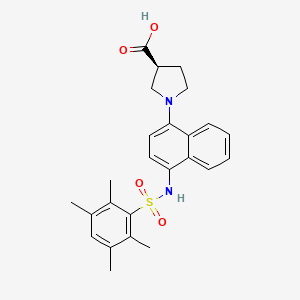
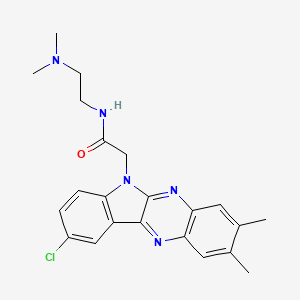
![4-[2-amino-5-[4-[(dimethylamino)methyl]thiophen-2-yl]pyridin-3-yl]-2-[(Z)-5,5,5-trifluoropent-3-en-2-yl]oxybenzamide](/img/structure/B610405.png)
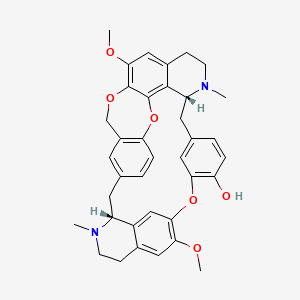
![5-(3,3-Dimethylbut-1-ynyl)-3-[[4-hydroxy-4-(oxolan-3-yloxymethyl)cyclohexyl]-(4-methylcyclohex-3-ene-1-carbonyl)amino]thiophene-2-carboxylic acid](/img/structure/B610407.png)

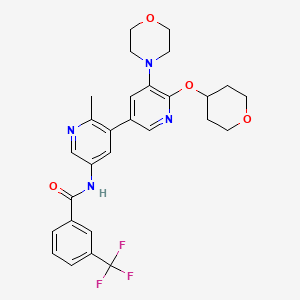
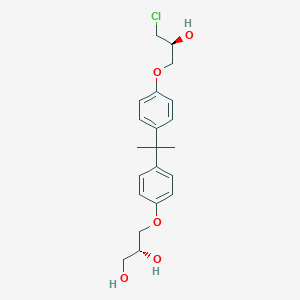
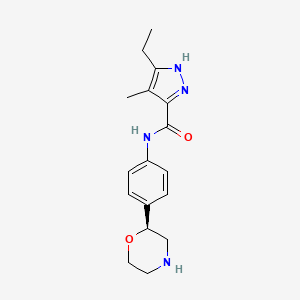
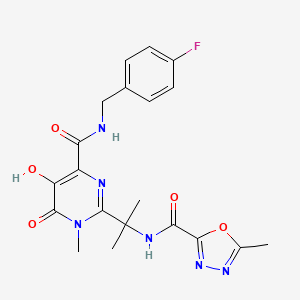
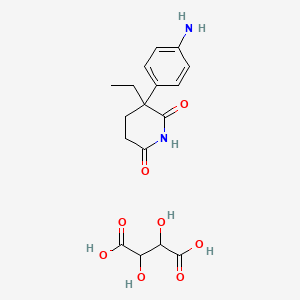
![[(1S,2S,3S,4S,5R,6S,8S,9R,13S,16S,17S)-11-ethyl-3,8,9-trihydroxy-4,6,16-trimethoxy-11-azahexacyclo[7.7.2.12,5.01,10.03,8.013,17]nonadecan-13-yl] 2-acetamidobenzoate](/img/structure/B610416.png)
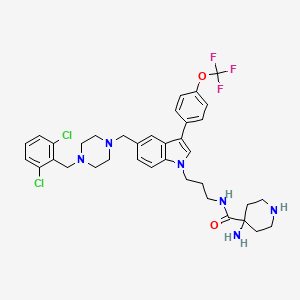
![1-[2-(4-Octylphenyl)ethyl]piperidin-4-ol](/img/structure/B610422.png)
